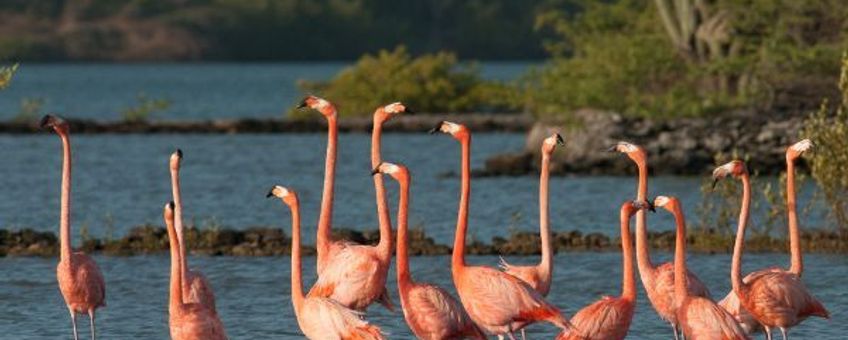
Nederland beschermt belangrijke draslanden op Curaçao
Bericht uitgegeven door Dutch Caribbean Nature Alliance (DCNA) [land] op [publicatiedatum]
De Nederlandse overheid heeft vier nieuwe draslanden (wetlands) van Internationaal belang aangewezen op het Nederlands Antilliaanse eiland Curaçao. Nederland heeft nu 53 zogenaamde ‘Ramsar Sites’ en staat hiermee op de vijfde plek na Groot-Brittannië, Mexico, Spanje en Australië. Tien ‘Ramsar Site’ draslanden horen bij de ABC eilanden. Een van de nieuwe ‘Ramsar Sites’ op Curaçao is Malpais / Sint Michiel, een belangrijk vogelgebied van 1,100 hectare. Je vindt er rode lijst soort Caraibische koet (Fulica caribaea) en de Caribische flamingo (Phoenicopterus ruber), maar ook de in Nederland voorkomende visdief (Sterna hirundo). Het gebied is zo bijzonder omdat er door de aanwezigheid van een dam zoet water, een schaars goed op het eiland, de grond in kan sijpelen. Dit water is essentieel voor de groei van bomen en struiken op het eiland.
Lees verder in het Engels......
The government of the Netherlands has designated four new coastal and near-coastal Wetlands of International Importance on the Netherlands Antilles island of Curaçao, a constituent country within the Kingdom of the Netherlands, in the Leeward Antilles 70 kilometer north of Venezuela. The Netherlands presently has 53 Ramsar Sites, the 5th highest national total after the United Kingdom, Mexico, Spain, and Australia. The ABC islands now boast a total of ten Ramsar sites.

Staff of the Carmabi Foundation (Caribbean Research and Management of Biodiversity) in Willemstad were helpful in the preparation of the designation materials. Ramsar’s Assistant Advisor for Europe, Ms Laura Máiz-Tomé, compiled brief Annotated List site descriptions based on the Ramsar Information Sheets. Below the description of the first site: Malpais / Sint Michiel.
Malpais / Sint Michiel
Malpais / Sint Michiel is an important Bird Area of 1,100 ha. Malpais is a former plantation just to the north of Sint Michiel. There are two freshwater lakes and the hyper-saline St. Michiel lagoon connected to a bay in which coral reefs are found, surrounded by dry deciduous vegetation and a well-developed woodland habitat. The area provides refugee for many birds, such as the IUCN Red Listed Caribbean coot (Fulica caribaea). The lagoon also supports a significant fraction of the global population of the Common tern (Sterna hirundo) and is part of a regional network of foraging sites for the Caribbean flamingo (Phoenicopterus ruber), protected under the Convention of Migratory Species. Freshwater is scarce in Curaçao and therefore of great ecological, social and economic value. The dam of Malpais is located downstream. Freshwater infiltrates into the soil, recharging groundwater reservoirs which allow woodlands to grow in the area. Some of the current threats which may affect the ecological character of the site are the landfill and runoff from a pig farm situated only 1km away.
Text: Nathaniel Miller, DCNA
Picture: Henkjan Kievit
Nederlandse inleiding: Sara Mulder, De Natuurkalender
